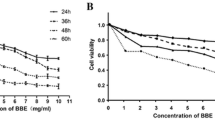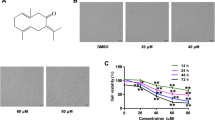Summary
The aim of this study was to investigate the effect of Paris saponin I (PS I) on human gastric carcinoma cell growth and apoptosis and to explore the potential mechanisms. The proliferation of SGC7901 cells was monitored by the MTT cell viability assay, while the nuclear morphology of apoptotic cells was assessed by Hoechst 33258 staining. Flow cytometry was performed to analyze the cell cycle progression of propidium iodide (PI)-stained SGC7901 cells and the apoptotic rate of annexin V/PI-stained cells. Western blotting was used to examine the expression of several cell cycle proteins, including cyclin B1 and Cdk1, and the apoptosis-regulated proteins Bcl-2, Bax, cytochrome c, procaspase-9, and procaspase-3. The MTT assay demonstrated that PS I could induce significant dose- and time-dependent inhibition of SGC7901 cell proliferation. Marked morphological changes, including condensation of chromatin, nuclear fragmentation and apoptotic bodies were clearly shown on Hoechst 33258 staining. PSI treatment also resulted in the disruption of the cell cycle at G2/M and the induction of apoptosis. Following PSI treatment, the cell cycle-related proteins cyclin B1 and Cdk1 were down-regulated. Expression of the pro-apoptotic protein Bax was increased, while anti-apoptotic protein Bcl-2 decreased. PSI treatment resulted in elevated cytoplasmic cytochrome c and activation of the apoptotic proteases caspase-9 and caspase-3. These data indicate that PS acts as an inhibitor of proli I feration in SGC7901 cells by inducing cell cycle arrest and mitochondria-dependent apoptosis. PSI is a potential therapeutic agent against human gastric carcinoma.
Similar content being viewed by others
References
Parkin DM. Global cancer statistics in the year 2000. Lancet Oncol, 2001,2(9):533–543
Parkin DM, Bray F, Ferlay J, et al. Global cancer statistics, 2002. CA Cancer J Clin, 2005,55(2):74–108
Yang L, Parkin DM, Ferlay J, et al. Estimates of cancer incidence in China for 2000 and projections for 2005. Cancer Epidemiol Biomarkers Prev, 2005,14(1):243–250
Ho JW, Leung YK, Chan CP. Herbal medicine in the treatment of cancer. Curr Med Chem Anti-Canc Agents, 2002,2(2):209–214
Lee MS, Yuet-Wa JC, Kong SK, et al. Effects of polyphyllin D, a steroidal saponin in Paris polyphylla, in growth inhibition of human breast cancer cells and in xenograft. Cancer Biol Ther, 2005,4(11):1248–1254
Cheung JY, Ong RC, Suen YK, et al. Polyphyllin D is a potent apoptosis inducer in drug-resistant HepG2 cells. Cancer Lett, 2005,217(2):203–211
Deng S, Yu B, Hui Y, et al. Synthesis of three diosgenyl saponins: dioscin, polyphyllin D, and balanitin 7. Carbohydr Res, 1999,317(1-4):53–62
Li B, Yu B, Hui Y, et al. An improved synthesis of the saponin, polyphyllin D. Carbohydr Res, 2001,331(1):1–7
Siu FM, Ma DL, Cheung YW, et al. Proteomic and transcriptomic study on the action of a cytotoxic saponin (Polyphyllin D): induction of endoplasmic reticulum stress and mitochondria-mediated apoptotic pathways. Proteomics, 2008,8(15):3105–3117
Xiao X, Bai P, Tri M, et al. The antitumoral effect of Paris Saponin Iassociated with the induction of apoptosis through the mitochondrial pathway. Mol Cancer Ther, 2009,8(5):1179–1188
Mossman T. Rapid colorimetric assay for cell growth and survival: application to proliferation and cytotoxicity assays. J Immunol Methods, 1983,65(1–2):55–63
Ramonede BM, Pérez-Tomás R. Activation of protein kinase C for protection of cells against apoptosis induced by the immunosuppressor prodigiosin. Biochem Pharmacol, 2002,63(3):463–469
Vinodhkumar R, Song YS, Devaki T. Romidepsin (depsipeptide) induced cell cycle arrest, apoptosis and histone hyperacetylation in lung carcinoma cells (A549) are associated with increase in p21 and hypophosphorylated retinoblastoma proteins expression. Biomed Pharmacother, 2008,62(2):85–93
Overbeeke R, Steffens-Nakken H, Vermes I, et al. Early features of apoptosis detected by four different flow cytometry assays. Apoptosis, 1998,3(2):115–121
Li H, Wang LJ, Qiu GF, et al. Apoptosis of Hela cells induced by extract from Cremanthodium humile. Food Chem Toxicol, 2007,45(10):2040–2046
Hsu YL, Kuo PL, Cho CY, et al. Antrodia cinnamomea fruiting bodies extract suppresses the invasive potential of human liver cancer cell line PLC/PRF/5 through inhibition of nuclear factor kappaB pathway. Food Chem Toxicol, 2007,45(7):1249–1257
Zoe AS, Matthew DW, Jennifer AP. Cell-cycle dysregulation and anticancer therapy. Trends Pharmacol Sci, 2003,24(3):139–145
Charles JS. The pezcoller lecture: cancer cell cycles revisited. Cancer Research, 2000,60(14):3689–3695
Matsui TA, Murata H, Sakabe T, et al. Sulforaphane induces cell cycle arrest and apoptosis in murine osteosarcoma cells in vitro and inhibits tumor growth in vivo. Oncol Rep, 2007,18(5):1263–1268
Chuang LT, Moqattash ST, Gretz HF, et al. Sulforaphane induces growth arrest and apoptosis in human ovarian cancer cells. Acta Obstet Gynecol Scand, 2007,16:1–6
Jakubikova J, Bao Y, Sedlak J. Isothiocyanates induce cell cycle arrest, apoptosis and mitochondrial potential depolarization in HL-60 and multidrug-resistant cell lines. Anticancer Res, 2005,25(5):3375–3386
Schafer KA. The cell cycle: a review. Vet Pathol, 1998,35(6):461–478
Nurse P. Universal control mechanism regulating onset of M-phase. Nature, 1990,344(6266):503–508
Morgan DO. Cyclin-dependent kinases: engines, clocks, and microprocessor. Annu Rev Cell Dev Biol, 1997, 13:261–291
Adams JM, Cory S. The Bcl-2 protein family: arbiters of cell survival. Science, 1998, 281(5381):1322–1326
Tang DG, Porter AT. Target to apoptosis: a hopeful weapon for prostate cancer. Prostate, 1997,32(4): 284–293
Reed JC. Regulation of apoptosis by bcl-2 family proteins and its role in cancer and chemoresistance. Curr Opin Oncol, 1995,7(6):541–546
Yang SH, Lu MC, Chien CM, et al. Induction of apoptosis in human leukemia K562 cells by cardiotoxin. III Life Sci, 2005,76(21): 2513–2522
Tsai CH, Yang SH, Chien CM, et al. Mechanisms of cardiotoxin lll-induced apoptosis in human colorectal cancer colo205 cells. Clin Exp Pharmacol Physiol, 2006,33(3):177–182
Lin HI, Lee YJ, Chen BF, et al. Involvement of Bcl-2 family, cytochrome c and caspase 3 in induction of apoptosis by beauvericin in human non-small cell lung cancer cells. Cancer Lett, 2005,230 (2):248–259
Kim DS, Jeon SE, Jeong YM, et al. Hydrogen peroxide is a mediator of indole-3-acetic acid/horseradish peroxidase-induced apoptosis. FEBS Lett, 2006,580(5):1439–1446
Zuliani T, Obriot H, Tual M, et al. Variable Bax antigenicity is linked to keratinocyte position within epidermal strata and UV-induced apoptosis. Exp Dermatol, 2008,17(2):125–132
Park SK, Kang H, Kwon CH. Caspase-dependent cell deathmediates potent cytotoxicity of sulfde derivatives of 9-anilinoacridine. Anticancer Drugs, 2008,19(4):381–389
Li P, Nijhawan D, Budihardjo I, et al. Cytochrome c and dATP-dependent formation of Apaf-1/caspase-9 complex initiates an apoptotic protease cascade. Cell, 1997,91(4): 479–489
Cheng AC, Jian CB, Huang YT, et al. Induction of apoptosis by Uncaria tomentosa through reactive oxygen species production, cytochrome c release, and caspases activation in human leukemia cells. Food Chem Toxicol, 2007,45(11):2206–2218
Author information
Authors and Affiliations
Corresponding author
Rights and permissions
About this article
Cite this article
Xiao, M., Dai, X., He, X. et al. Paris saponin I induces G2/M cell cycle arrest and apoptosis in human gastric carcinoma SGC7901 cells. J. Huazhong Univ. Sci. Technol. [Med. Sci.] 31, 768–772 (2011). https://doi.org/10.1007/s11596-011-0674-y
Received:
Published:
Issue Date:
DOI: https://doi.org/10.1007/s11596-011-0674-y




